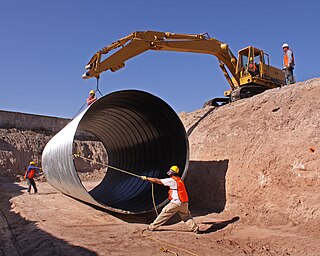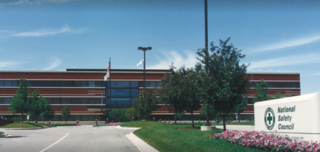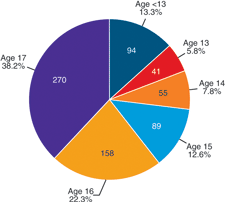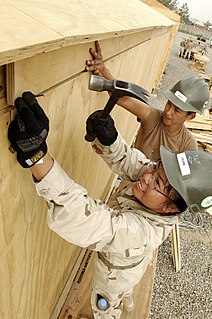The Occupational Safety and Health Administration is a large regulatory agency of the United States Department of Labor that originally had federal visitorial powers to inspect and examine workplaces. Congress established the agency under the Occupational Safety and Health Act OSH Act, which President Richard M. Nixon signed into law on December 29, 1970. OSHA's mission is to "assure safe and healthy working conditions for working men and women by setting and enforcing standards and by providing training, outreach, education and assistance". The agency is also charged with enforcing a variety of whistleblower statutes and regulations. OSHA's workplace safety inspections have been shown to reduce injury rates and injury costs without adverse effects to employment, sales, credit ratings or firm survival.

Workers' compensation or workers' comp is a form of insurance providing wage replacement and medical benefits to employees injured in the course of employment in exchange for mandatory relinquishment of the employee's right to sue his or her employer for the tort of negligence. The trade-off between assured, limited coverage and lack of recourse outside the worker compensation system is known as "the compensation bargain". One of the problems that the compensation bargain solved is the problem of employers becoming insolvent as a result of high damage awards. The system of collective liability was created to prevent that, and thus to ensure security of compensation to the workers.

The Occupational Safety and Health Act of 1970 is a US labor law governing the federal law of occupational health and safety in the private sector and federal government in the United States. It was enacted by Congress in 1970 and was signed by President Richard Nixon on December 29, 1970. Its main goal is to ensure that employers provide employees with an environment free from recognized hazards, such as exposure to toxic chemicals, excessive noise levels, mechanical dangers, heat or cold stress, or unsanitary conditions. The Act created the Occupational Safety and Health Administration (OSHA) and the National Institute for Occupational Safety and Health (NIOSH).
The threshold limit value (TLV) is believed to be a level to which a worker can be exposed per shift in the worktime without adverse effects. Strictly speaking, TLV is a reserved term of the American Conference of Governmental Industrial Hygienists (ACGIH). TLVs issued by the ACGIH are the most widely accepted occupational exposure limits both in the United States and most other countries. However, it is sometimes loosely used to refer to other similar concepts used in occupational health and toxicology, such as acceptable daily intake (ADI) and tolerable daily intake (TDI). Concepts such as TLV, ADI, and TDI can be compared to the no-observed-adverse-effect level (NOAEL) in animal testing, but whereas a NOAEL can be established experimentally during a short period, TLV, ADI, and TDI apply to human beings over a lifetime and thus are harder to test empirically and are usually set at lower levels. TLVs, along with biological exposure indices (BEIs), are published annually by the ACGIH.

The National Safety Council (NSC) is a 501(c)(3) nonprofit, public service organization promoting health and safety in the United States. Headquartered in Itasca, Illinois, NSC is a member organization, founded in 1913 and granted a congressional charter in 1953. Members include more than 55,000 businesses, labor organizations, schools, public agencies, private groups and individuals.
The Michigan Occupational Safety and Health Administration (MIOSHA) is a state government agency that regulates workplace safety and health in the U.S. state of Michigan. Michigan OSHA is an agency within the Michigan Department of Licensing and Regulatory Affairs and operates under a formal state-plan agreement with the Occupational Safety and Health Administration (OSHA).
Environment (E), health (H) and safety (S),EHS is an acronym for the set that studies and implements the practical aspects of protecting the environment and maintaining health and safety at occupation. In simple terms it is what organizations must do to make sure that their activities do not cause harm to anyone. Commonly, quality - quality assurance and quality control - is adjoined to form the company division known as HSQE.
The Division of Occupational Safety and Health of California is an agency of the Government of California established by the California Occupational Safety & Health Act of 1973. Administered by the California Department of Industrial Relations, Cal/OSHA's mission is to protect public health and safety through research and regulation related to hazards on the job in California workplaces as well as on elevators, amusement rides, and ski lifts, and related to the use of pressure vessels such as boilers and tanks. Cal/OSHA requires that qualifying organizations create illness and injury prevention programs meant to help identify and eliminate dangers before accidents and illnesses occur.
"Right to know" empowers "people by allowing them to participate in an informed way in decisions that affect them, while also holding governments and others accountable". It pursues universal access to information as essential foundations of inclusive knowledge societies.

Around the world, nearly 250 million children, about one in every six children, ages 5 through 17, are involved in child labor. Children can be found in almost any economic sector. However, at a global level, most of them work in agriculture (70%). Approximately 2.4 million adolescents aged 16 to 17 years worked in the U.S. in 2006. Official employment statistics are not available for younger adolescents who are also known to work, especially in agricultural settings.

The California Labor Code, more formally known as "the Labor Code", is a collection of civil law statutes for the State of California. The code is made up of statutes which govern the general obligations and rights of persons within the jurisdiction of the State of California. The stated goal of the Department of Industrial Relations is to promote and develop the welfare of the wage earners of California, to improve their working conditions and to advance their opportunities for profitable employment."
An occupational fatality is a death that occurs while a person is at work or performing work related tasks. Occupational fatalities are also commonly called “occupational deaths” or “work-related deaths/fatalities” and can occur in any industry or occupation.

Edwin Foulke is an American lawyer who served as the Assistant Secretary of Labor. In 2006, Foulke was nominated by U.S. President George W. Bush to head the Occupational Safety and Health Administration and had assumed the position until November 2008. Foulke is currently a partner at Fisher & Phillips in Atlanta, Georgia.

A physical hazard is an agent, factor or circumstance that can cause harm with contact. They can be classified as type of occupational hazard or environmental hazard. Physical hazards include ergonomic hazards, radiation, heat and cold stress, vibration hazards, and noise hazards. Engineering controls are often used to mitigate physical hazards.

Occupational safety and health (OSH), also commonly referred to as occupational health and safety (OHS), occupational health, or occupational safety, is a multidisciplinary field concerned with the safety, health, and welfare of people at work. These terms also refer to the goals of this field, so their use in the sense of this article was originally an abbreviation of occupational safety and health program/department etc.
The California Department of Industrial Relations (DIR) is a department of the government of the state of California which was initially created in 1927. The department is currently part of the Cabinet-level California Labor and Workforce Development Agency, and headquartered at the Elihu M. Harris State Office Building in Oakland.
The American Industrial Hygiene Association (AIHA) is a 501(c)6 non-profit organization, whose mission is "Creating knowledge to protect worker health." The American Industrial Hygiene Association works to provide information and resources to Industrial Hygienists and Occupational Health professionals.

The Mount Sinai Selikoff Centers for Occupational Health are a set of occupational and environmental health clinics that focus on the prevention, diagnosis, and treatment of workplace injuries and illnesses. Significant injuries and illnesses that are treated at the clinical centers include occupational lung cancers, manganese/silica/lead exposures, and asbestos-related illness, which was the career-long research of Dr. Irving Selikoff, the centers' inaugural director. The Selikoff Centers for Occupational Health's multidisciplinary health care team includes physicians, nurse practitioners, industrial hygienists, ergonomists, social workers, and benefits specialists, who are "leaders in the prevention, diagnosis and treatment of workplace injuries and illnesses," and provide comprehensive patient-centered services in New York City and Lower Hudson Valley. The clinical centers are located within the Icahn School of Medicine at Mount Sinai under the Division of Occupational and Environmental Medicine.
The Washington State Department of Labor and Industries (L&I) is a department of the Washington state government that regulates and enforces labor standards. The agency administers the state's workers' compensation system, conducts workplace inspections, licenses and certifies trade workers, and issues permits for heavy machinery.

Workplace robotics safety is an aspect of occupational safety and health when robots are used in the workplace. This includes traditional industrial robots as well as emerging technologies such as drone aircraft and wearable robotic exoskeletons. Types of accidents include collisions, crushing, and injuries from mechanical parts. Hazard controls include physical barriers, good work practices, and proper maintenance. Previous research showed that robot application is associated with an increase in the rate of occupational injuries in the first two years, and then becomes insignificant and even negative afterwards. Local governments can reduce or even eliminate the effect of robot application on occupational injuries by strengthening safety regulations. In addition, although local governments are keen on pushing robot application and industrial intelligence, the wide application of robots may impose a burden on the public health expenditure of local governments due to occupational injuries.









